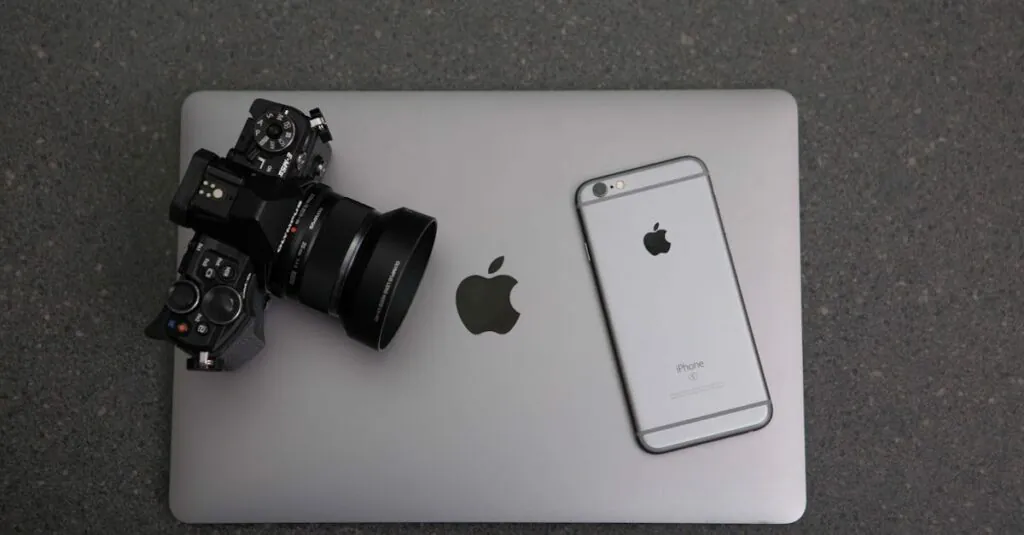Table of Contents
ToggleImagine this: you’re ready to capture that perfect sunset or a silly selfie, but your iPhone camera decides to play hide and seek. Frustrating, right? It’s like your phone’s saying, “Not today, my friend!” Whether it’s a stubborn app or a sneaky software glitch, a malfunctioning camera can turn your photo dreams into a pixelated nightmare.
Common Issues Causing Camera Problems
Various factors can contribute to camera malfunctions on an iPhone. Understanding these common issues helps in addressing them effectively.
Software Glitches
Software glitches often lead to unexpected camera behavior. Apps running in the background may interfere with the camera’s functionality. Regular system updates also play a crucial role; outdated software can result in bugs affecting the camera. Restarting the device frequently resolves minor glitches. Changing camera settings might also restore proper functionality.
Hardware Malfunctions
Hardware malfunctions pose significant challenges for iPhone users. Physical damage such as cracked lenses or water exposure can impede camera operation. Removing any protective cases may help if they obstruct the camera. Obstructions like debris can cause focusing issues. When the issue persists despite these checks, seeking professional repair is advisable. Identifying the problem early increases the chances of a successful fix.
Basic Troubleshooting Steps
Troubleshooting a camera issue on an iPhone often involves straightforward solutions. These basic steps can help diagnose and resolve common problems effectively.
Restarting Your iPhone
Restarting the device can clear temporary glitches that interfere with the camera functionality. To perform a restart, press and hold the side button along with the volume button until the power slider appears. Users can then drag the slider to turn off the iPhone. After waiting approximately 30 seconds, pressing the side button again will turn the device back on. This simple action resets active processes and may restore camera performance quickly.
Updating iOS
Updating to the latest iOS version can enhance device functionality and fix known issues. To check for updates, navigate to Settings, select General, then tap Software Update. If an update is available, users can initiate the download and installation process. Having the most current software often resolves compatibility issues that affect camera operation. Ensuring this step is taken regularly contributes to overall system stability and performance.
Checking Camera Settings
Checking camera settings is essential for resolving issues with the iPhone camera. Ensuring everything is configured correctly can lead to quick fixes.
App Permissions
Sometimes, camera issues arise from restricted app permissions. Check if the camera app has the necessary access enabled. Navigate to Settings, then Privacy, and select Camera. You’ll find a list of apps that request camera access. Enable the toggle for any app that requires it, allowing full functionality. A lack of permission may restrict some features, preventing proper operation.
Camera Mode Settings
Camera mode settings play a crucial role in the camera’s performance. Switching between different modes can help diagnose the problem. Open the camera app and review the mode at the bottom of the screen. Options include Photo, Video, Portrait, and others. Ensure you’re not in an alternative mode that may be causing issues, such as a time-lapse or panorama mode. Adjusting to the standard Photo mode often resolves unexpected behavior.
Advanced Solutions
In some cases, deeper troubleshooting methods can resolve persistent camera issues on an iPhone. These advanced solutions include resetting all settings and performing a factory reset.
Resetting All Settings
Resetting all settings can restore functionality without erasing personal data. This option reinstates the original settings for network configurations, display preferences, and other systems. To execute this, navigate to Settings, select General, then tap on Reset, and choose Reset All Settings. Users must enter their passcode to confirm the action. This process may resolve persistent issues without the need for data loss.
Factory Reset
A factory reset serves as a last resort for fixing malfunctioning cameras. This method erases all content on the iPhone, restoring it to its original factory settings. Before proceeding, ensure all essential data is backed up through iCloud or iTunes. To initiate a factory reset, go to Settings, tap General, select Reset, and then choose Erase All Content and Settings. Once completed, users can restore their information from the backup, addressing deep-rooted software problems effectively.
When to Seek Professional Help
Persistent issues with an iPhone camera may indicate the need for professional assistance. Not every problem can be solved through basic troubleshooting steps.
Contacting Apple Support
Reaching out to Apple Support provides a direct line to expert assistance. They can help diagnose software-related issues that basic troubleshooting cannot resolve. Access to their resources offers insights into common problems and specialized advice for specific situations. Users can utilize the support app or website to set up a call or chat. Having the device’s serial number ready can streamline the process. Apple technicians often guide users through steps tailored to individual problems, enhancing the likelihood of a quick resolution.
Visiting a Repair Shop
Choosing to visit a certified repair shop can address hardware problems effectively. An experienced technician can examine the device for physical damage or internal issues. Bringing the phone in allows for hands-on diagnostics that can’t occur remotely. Users should ensure that the shop is authorized by Apple to maintain warranty coverage. Repairs at authorized locations often utilize genuine parts, further supporting long-term functionality. Many shops also provide quick turnaround times, minimizing inconveniences for users needing their cameras in working condition.
Experiencing camera issues on an iPhone can be frustrating but understanding the potential causes can lead to effective solutions. By following the troubleshooting steps outlined in the article users can often resolve common problems themselves. Simple actions like restarting the device or updating the software can make a significant difference.
However if the issues persist it may be time to seek professional help. Whether it’s contacting Apple Support for software fixes or visiting a certified repair shop for hardware concerns getting expert assistance ensures that the camera functions properly again. With the right approach users can get back to capturing those precious moments without hassle.




